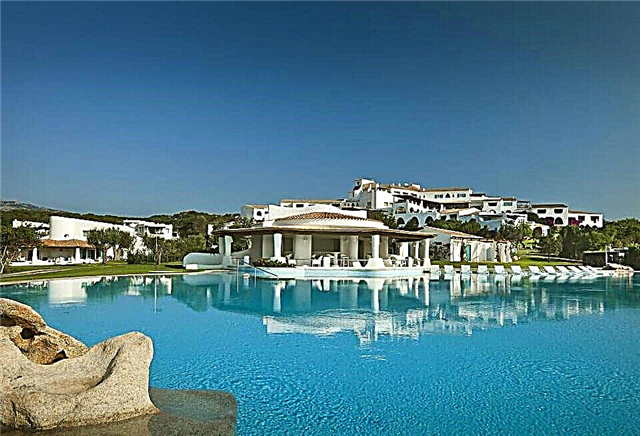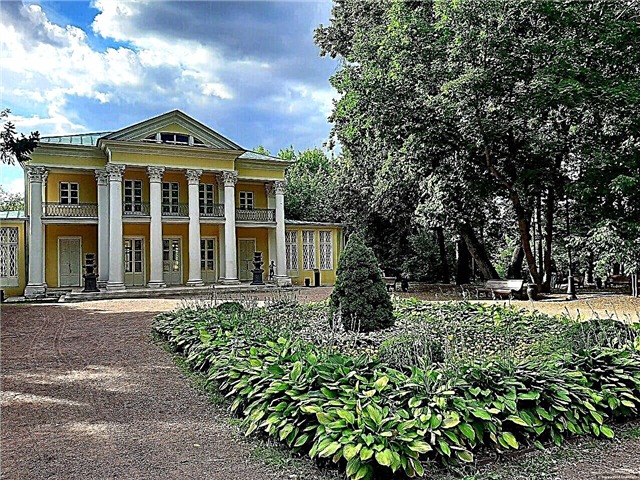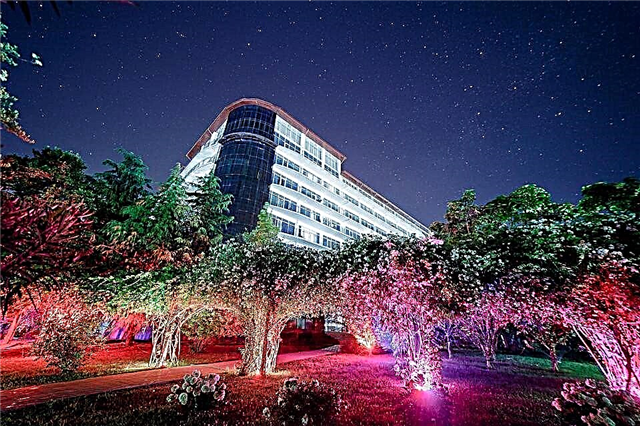Address: Russia, Yaroslavl region, Yaroslavl, Bogoyavlenskaya square, 12
Start of construction: 1684 year
Start of construction: 1693 year
Coordinates: 57 ° 37'17.9 "N 39 ° 53'11.2" E
Cultural heritage site of the Russian Federation
Content:
One of the first pillarless churches in Yaroslavl attracts the attention of everyone passing along the Moscow highway. Visually, it is the dominant feature of the Kotorosl embankment and immediately stands out in the panorama of the city, which opens from the bridge over the river. Great, but today we have the opportunity to see the facades of the church decorated with unique polychrome tiles, as well as luxurious wall paintings made at the end of the 17th century.
History of the Epiphany Church
Initially, where the temple now stands, the usual courtyards of the townspeople were located. At the beginning of the 16th century, by decree of Tsar Vasily III, these lands were transferred to the jurisdiction of the Spaso-Preobrazhensky Monastery, which built here a wooden Epiphany Church and a monastic stable yard. And already in the 17th century, after the Polish-Lithuanian invasion, “monastery people” began to live in the smallest settlement of the monastery. And they began to call it after the church - Epiphany.

View of the church from the east
According to other historical studies, the Epiphany wooden temple has been here since the 13th century. That is, since the pre-Mongol period in the history of Russia.
The construction of the brick temple began in 1684, and its construction took 9 years. At the time, it was very expensive and required a lot of money. They were found at the local eminent merchant, a member of the Yaroslavl "living room of the hundred" Alexei Abramovich Zubchaninov. It is interesting that his ancestors were the "pawns" of the Transfiguration monastery. That is, people who have invested in the construction of this monastery. So Zubchaninov represented a whole dynasty of Yaroslavl benefactors. In addition to merchants, there were also monks and priests in the Zubchaninov family.
The merchant owned 24 shops in Yaroslavl, where they sold well-dressed leather. And his family has long lived in Epiphany Sloboda. The name of Zubchaninov was indicated in the chronicle of the temple near the altar. But it has not survived to this day. And the existence of such an inscription became known from the printed works of former researchers of ancient Russian architecture, who found this memorial brand still intact. Zubchaninov was buried on the territory of the Spassko-Preobrazhenskaya monastery.

Church from the Kholmogory road
In 1692-1693, the church was painted by Yaroslavl master-isographers, led by Dmitry Plekhanov and Fyodor Ignatiev, recognized as the best painters of their time. Some researchers believe that the famous Gury Nikitich Kineshemtsev could have taken part in the painting of the temple vaults.
The Epiphany Church has always been an ordinary posad church. For a long time, the work of the clergy was paid for by the parish community itself or by private donors. And although the parish was small - about 200 people, the temple was never deprived of liturgical utensils and found the necessary money for repair work.
In the 30s of the XIX century, a brick fence was built around the church. And in 1886, large-scale repairs were made in it, the money for which was allocated by the Yaroslavl merchant Vasily Yakovlevich Kuznetsov.
According to the inventories that were compiled by the ministers of the church several times during its history, there were three unique shrines in the Epiphany Church. Two of them were irretrievably lost in the last century. This is an altar cross with a piece of the Cross of the Lord and the head of John the Baptist carved out of wood. Until now, it has been possible to preserve only a large altarpiece wooden cross, unique in its craftsmanship.

View of the church with a bell tower and the main entrance
With the advent of Soviet power, the temple was closed. It was located in the very center of the city and suffered greatly during the White Guard uprising against the new government. As a result of shelling and fires in 1918, the walls of the southern and western facades were damaged, and large kokoshniks were also badly broken. An artillery shell hit directly into the chapel located to the south. And this part of the temple was almost completely burned out due to the fire. Since there was plenty of destruction in the city, no funds were allocated for the restoration of the Epiphany Church. For decades it stood almost without a roof and with broken walls.
However, despite such a difficult situation, the parish community supported the church until 1927 as best they could. Then the authorities recognized it as an architectural monument and gave it to the provincial administration of museums. But no funds were allocated for the restoration, and the temple continued to decay. Moreover, in 1938, a garage and a car repair shop were located here, which further destroyed the ancient church.
However, the church has waited for better times. In the middle of the last century, large-scale restoration work was carried out in it. During them, the temple was restored to its original appearance - the roof, onion domes, window frames and unique glazed tiles decorating the facades of the building were restored. And in 2000, restoration work was continued.

View of the north facade of the church
Architecture and interior decoration of the Epiphany Church
In the architecture of the temple, the great influence of the Moscow architects of that time can be traced. In fact, it became a kind of fusion of the architectural traditions of Moscow and Yaroslavl, which was a real artistic innovation for the city of the late 17th century.
The pillarless church, in the style of the capital, has no basement and on three sides, as was customary among Yaroslavl architects, is surrounded by galleries. The influence of Muscovites was also manifested in the design of the church with two rows of large, elegant kokoshniks. They serve as the base on which stand tall, slender muffled drums topped with five neat onion domes.
The high hipped bell tower has eight sides traditional for that time. It is placed from the north-west of the main building of the temple and is separated from it by a narrow opening.
The church is adorned with richly decorated facades, where beautiful multicolored tiles stand out. In terms of location and color scheme, they are in perfect harmony with the entire architecture of the temple. The tiles are decorated with a stylized floral ornament. This ornament is repeated on the tiles that are located on cornices, ribbons and other extended decorative elements that outline the main silhouette of the church. And on the tiles, placed on vertical elements that emphasize the height of the temple, the ornament has a centric, closed pattern. In terms of volume, quality and frequency of use of glazed tiles, the Epiphany Church is unmatched. And it is not surprising that such a luxurious tiled decor made an indelible impression on contemporaries.

South facade of the church
Inside the church you feel as if you are in a fairytale tower from old Russian epics. It is very spacious and light here. This sense of volumetric light space is achieved through a high four-part closed vault, as well as nine large windows.
It is wonderful that today we can admire the murals that have come down to our days since 1693! The color scheme is dominated by golden, blue and red shades. And such a palette makes the drawings visually richer and richer. According to tradition, the main subjects for the frescoes made on the walls were scenes revealing the content of the Gospel on the theme of the life and suffering of Christ.
The gilded carved iconostasis made in the Baroque style at the end of the 17th century looks very harmonious with the frescoes. Researchers believe that it was ordered for the opening of the church and was not changed all this time. This magnificent iconostasis, according to art critics, could have been made by the famous carver Semyon Spiridonovich Kholmogorets.
The current state of the temple and the visiting regime
Many pilgrims and tourists come to the temple - a real pearl of the "Golden Ring" of Russia. The Epiphany Church is a functioning Orthodox church. Services are held there at 8.00 and 17.00, and on Sundays and holidays - at 9.00 and 17.00. Patronal holidays are celebrated on January 19 and July 16. At the same time, the temple is a branch of the Yaroslavl Museum of the Reserve and is open to visitors from 9.00 to 16.00 on all days of the week, except Monday and Tuesday. The church has three thrones, the main one of which is dedicated to the Baptism of the Lord (or Epiphany).

Fragment of the eastern facade of the church
How to get to the Epiphany Church
The church is located in Yaroslavl on Epiphany Square, 12, near the Moscow Bridge over the Korotosl River, across the street from the Transfiguration Monastery.
By car. The federal highway M8 leads from Moscow to Yaroslavl. Within the city limits, it is called Moskovsky Prospect. The church is on the left, just behind the road bridge over the Korotosl River.
By train. From Moscow to Yaroslavl, express train trains reach in 3 hours 16 minutes. The journey by regular train takes from 4 to 5.5 hours. From Moskovsky Train Station in Yaroslavl, the distance to the Epiphany Church is 2.5 km. You can walk to it, as well as drive up by bus or minibus.











